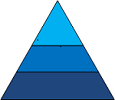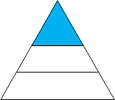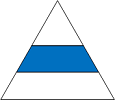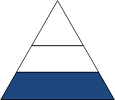 Why Information Pyramids on the Land-use Knowledge Network Website?
Why Information Pyramids on the Land-use Knowledge Network Website?
Information pyramids are a core concept for presenting essential information on the Land-use Knowledge Network’s website.
When you see a document with a pyramid in the top right hand corner, you are seeing information that has has been screened and sifted by knowledgeable experts and is judged to be most useful, current and guides to good practices and knowledge in terms of current experience, research and regulations. Some topics have a series of articles that begin with a summary article that introduces some essentials (foundational concepts plus high-level learnings) plus a list of the checklists, factsheets and detailed information resources that make up the current information pyramid for a topic. Wellsite Construction and Reclamation in the Boreal Forest is an example of a summary article.
 At the top of an information pyramid is the knowledge summary for a topic. The knowledge summary presents the community of experts' checklist of what to pay attention to, what to avoid and what is on the horizon. When you see a pyramid with a coloured top layer you are looking at the current knowledge summary for that topic. Checklist: Wellsite Construction in the Boreal Forest is an example of a knowledge summary.
At the top of an information pyramid is the knowledge summary for a topic. The knowledge summary presents the community of experts' checklist of what to pay attention to, what to avoid and what is on the horizon. When you see a pyramid with a coloured top layer you are looking at the current knowledge summary for that topic. Checklist: Wellsite Construction in the Boreal Forest is an example of a knowledge summary.
 The factsheet level of a topic's information pyramid presents the "How To's", the current good practices as determined by knowledgeable experts. A pyramid with a coloured middle section identifies a factsheet. Good Practices: Wellsite Construction in the Boreal Forest is an example of a factsheet.
The factsheet level of a topic's information pyramid presents the "How To's", the current good practices as determined by knowledgeable experts. A pyramid with a coloured middle section identifies a factsheet. Good Practices: Wellsite Construction in the Boreal Forest is an example of a factsheet.
 The Details layer of the information pyramid presents the research articles, manuals, reports and regulatory instructions that are judged most useful by the community of experts. Information pyramids do not cover all the information on a topic, just the most relevant, robustly useful and foundational to the topic. Operating Conditions: Enhanced Approval Process is an example of a regulatory manual guiding wellsite construction and reclamation processes.
The Details layer of the information pyramid presents the research articles, manuals, reports and regulatory instructions that are judged most useful by the community of experts. Information pyramids do not cover all the information on a topic, just the most relevant, robustly useful and foundational to the topic. Operating Conditions: Enhanced Approval Process is an example of a regulatory manual guiding wellsite construction and reclamation processes.
When you see the pyramid symbol on an article, you know it has gone through the review by a community of experts to be on the Land-use Knowledge Network website.
Information Pyramids Pioneered By:
The concept of Information Pyramids was pioneered by Ron Weisenburger, the first Chief Knowledge Officer for the Government of Alberta. Ron worked with a group of forage and beef researchers to develop an information pyramid for cow-calf producers on the website, www.foragebeef.ca.
The foragebeef.ca website doesn’t present all the information that is available on forage production and cow-calf production. It presents what the researchers thought was the best of current information. Ron Weisenburger led the information assembly and review process by researchers and extension specialists in Western Canada (both federal and provincial government). For its time, it was a revolutionary concept in delivering really good information in a small footprint. The links allow a user to journey down to the material he/she is unfamiliar with. It also provides the opportunity to remind users to pay attention to fundamentals or key learnings they may have forgotten.
Information Pyramid Concepts
Here are the details of what is involved in an information pyramid. It starts with a community of experts, the practitioners the researchers, the trainers, the regulators.
At the core of an Information Pyramid is the community of experts. A really good expert sifts through the mass of information in their field, finds and rates “good” information and then shares that good information succinctly with clients and peers.
It is really useful information to a client if the expert summarizes the information as:
- What to Do
- What to Avoid
- What is Coming Over the Horizon
When this is done well, this is not just timely information; it is knowledge since it has had the sieve of the expert’s know-how and what the expert considers essential information to know about. Hence we call these “Knowledge Summaries”.
A really good knowledge summary is a checklist. Individual points summarize in 140 characters or less, a Twitter sized comment, and link to deeper, more detailed information. So, the knowledge summary should link down to the “How To’s”, the short factsheet articles. The “How To’s” should link down to the detailed manual or guide, the reference material and research papers and reports.
The knowledge summary at the top of a information pyramid changes with current and emerging conditions. So the pathway down to the deeper, more detailed information will change regularly. The reference material is more static.
A well-built information pyramid provides value by directing the client to information that is important for current conditions. Properly built, a information pyramid will cover a variety of commonly recurring situations.
As exceptional events happen, the experts augment the information pyramid to summarize and guide clients to best responses to the new challenge. Information pyramids are a solution to info-glut and just-in-time information. They provided a guided path to relevant information for current issues. But they require frequent updating by experts on the knowledge summaries to stay current.
But what is the value of an expert if the expert does not provide timely advice and a pathway to more detailed learning by the client?
How the Land-use Knowledge Network Will Develop Information Pyramids
The Land-use Knowledge Network intends to develop content in concert with networks of experts (through the existing professional institutes, associations and organizations that are involved in aspects of land-use management). Information pyramids will be developed in consultation with the organizations and experts who can summarize what is the most relevant information on a land-use issue. The intent is not to present the wide range of information on a topic but good information that has been sifted by experts.






